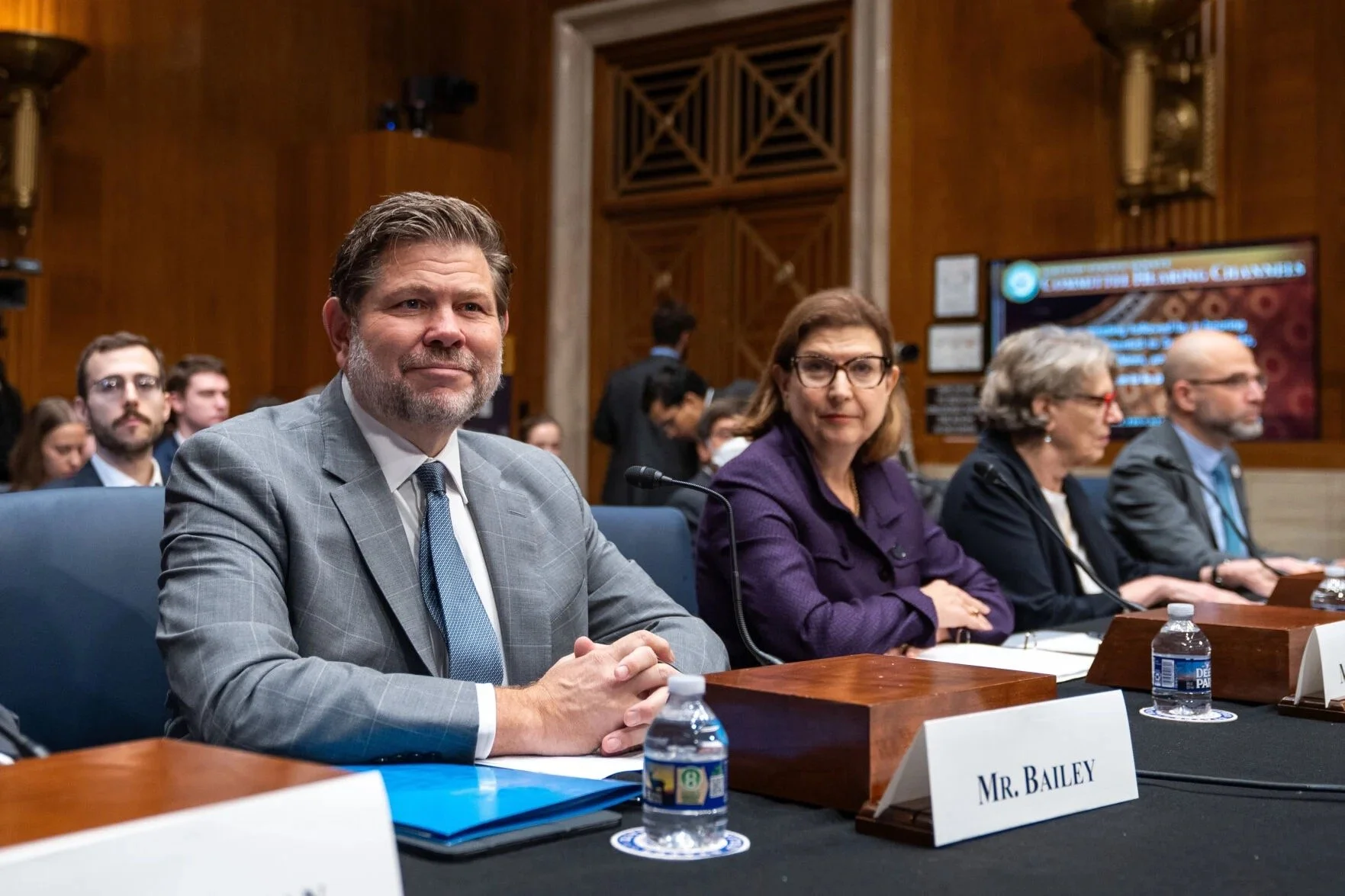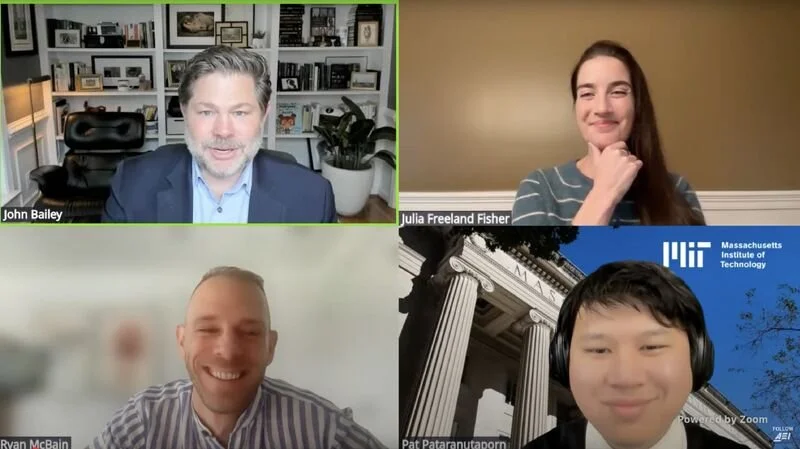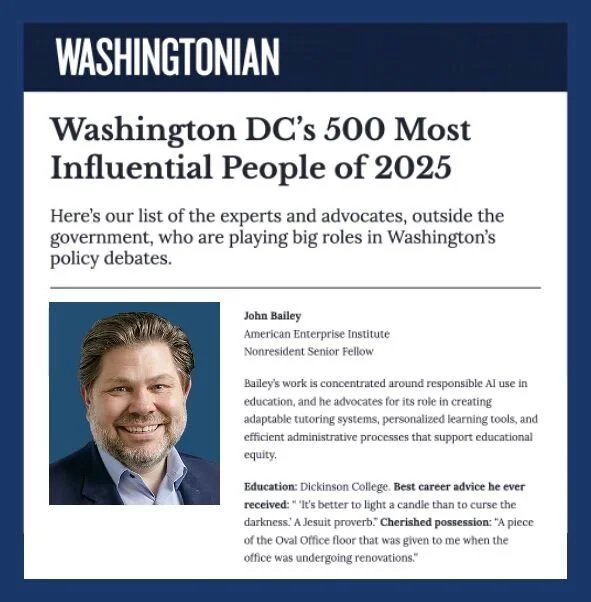
John Bailey
John serves as a strategic advisor and investor, leveraging cross-sector experience in government, philanthropy, and the private sector to drive solutions in AI, technology, workforce development, climate technology, and behavioral health.
He currently serves as a fellow at the Chan Zuckerberg Initiative and a Non-Resident Senior Fellow at the American Enterprise Institute. He has supported a range of investors and philanthropies with designing their strategies, launching initiatives, and developing policy agendas.
John served as a domestic policy advisor in the White House where he coordinated the Bush Administration's efforts during the credit crisis to stabilize $200 billion in student loans and served as a negotiator for the reauthorization of the Trade Adjustment Assistance program. As the Deputy Policy Director to the U.S. Secretary of Commerce, he contributed to the first national pandemic preparedness strategy and worked on policies related to American competitiveness and comprehensive immigration reform.
He co-founded the strategic advisory firm Whiteboard Advisors and served as a senior program officer at the Bill and Melinda Gates Foundation. Earlier in his career, John served as the nation's second Director of Educational Technology at the U.S. Department of Education, where he co-chaired the interagency Advanced Education Technology Initiative. While working for Pennsylvania Governor Tom Ridge, John spearheaded several technology and education initiatives, including a statewide broadband mapping project.
John currently serves on the board of directors for Zearn Math, the Federation of American Scientists, U.S. Digital Response, the Just Trust, and American Policy Ventures. He also serves on advisory boards for Trustible.ai, the XPRIZE, the FPF Center for Artificial Intelligence, and the Tech Talent Project. In addition, John is a Pahara-Aspen Institute Fellow and a moderator and member of the Aspen Global Leadership Network. He is also an alumnus of the American Council on Germany Young Leaders Program. In 2022, 2023, and 2024 the Washingtonian named him as one of Washington's Most Influential People in policy.
He previously served on boards for the Aspen Institute’s Future of Work, Indego Africa, and the Data Quality Campaign.
Featured Writing
I was honored to testify before the Senate HELP Committee, in my capacity as a Non-Resident Senior Fellow at AEI, on how AI can strengthen support for patients, workers, children, and families. It is no secret that I am an optimist about AI’s promise to expand opportunity and make learning more personal. But optimism must be matched with responsibility, including being honest about the emerging challenges and risks. As AI becomes more persuasive and more present in classrooms, we need to take seriously the risks of over-reliance, misalignment with educational goals, and emotional dependence on systems designed to imitate empathy.
A recent webinar with Julia Freeland Fisher, Ryan McBain, and Pat Pataranutaporn explored how AI is learning to simulate warmth, patience, and compassion—traits that make systems feel empathetic. These advances promise major benefits, including personalized tutoring, mental-health support, and reduced loneliness, but also raise concerns about dependency, weakened human bonds, and manipulative “addictive intelligence.” Experts urged designing AI that promotes human flourishing, measuring emotional and social well-being—not just accuracy—and enforcing transparency and child-safety standards. The central question: can AI empathy strengthen human connection rather than replace it?
OpenAI’s GPT-5 introduces a breakthrough in AI safety: real-time monitoring of its internal reasoning, or chain-of-thought (CoT). GPT-5 cut deceptive reasoning from 4.8% in earlier models to 2.1%, with 81% precision and 84% recall in flagging risks. Yet studies warn this interpretability may erode as models evolve toward opaque, machine-optimized reasoning. Both OpenAI and academic researchers urge treating CoT readability as a core safety metric—measured, reported, and preserved through training—to ensure humans retain visibility into how advanced AI systems reason, decide, and potentially deceive.
The White House’s 2025 AI Action Plan outlines an ambitious roadmap aimed at securing America’s global leadership in artificial intelligence through rapid innovation, strategic infrastructure, and assertive international engagement. Emphasizing open-source models, regulatory sandboxes, and workforce initiatives, the plan boldly contrasts previous approaches by accelerating deployment and competitiveness over precautionary regulation. However, critical gaps remain in AI interpretability, state-federal dynamics, copyright clarity, and execution specifics. The ultimate measure of success will depend not merely on technological advancement, but on ensuring responsible governance, maintaining public trust, and effectively managing AI’s profound risks alongside its transformative opportunities.
Google I/O 2025 underscored a pivotal shift toward the "Intelligence of Things," embedding advanced AI into everyday tools and devices, seamlessly integrating technology into daily life rather than creating isolated products. Google's vision emphasizes proactive, personalized AI, exemplified by Gemini 2.5’s deep research tools and immersive communication innovations like Beam and real-time multilingual translation in Google Meet. The event highlighted AI's transformative impact on education, notably through Project Astra's multimodal learning capabilities and LearnLM’s integration into Gemini, significantly enhancing pedagogical effectiveness. Central to this evolution is the critical role of agile public policy in facilitating safe innovation, ensuring AI technologies serve human needs by enhancing safety, productivity, and quality of life.
Meta was kind enough to extend an invitation for me to attend its inaugural LlamaCon—a one-day developer summit devoted to the Llama family of open-source large language models. It offered the chance to better understand the direction in which both the technology and its surrounding ecosystem are moving, and therefore merits a close read by anyone shaping AI strategy or policy.
It’s an honor to be named among Washingtonian Magazine's Most Influential People, alongside so many exceptional leaders whom I deeply admire, learn from, and have the privilege to work with.
AI is advancing faster than anyone expected — and the 2025 AI Index Report proves it. From AI models matching Nobel-level intellect to a 280x drop in computing costs, Stanford’s latest report maps the jaw-dropping acceleration of AI capabilities. The U.S. still leads in AI models and private investment, but China is closing the quality gap—and fast. Meanwhile, AI-driven labs are already making major scientific breakthroughs, like designing nanobodies to fight COVID-19, and outperforming doctors in diagnostic accuracy.
AI is transforming the workplace by enhancing collaboration, speeding up tasks, and expanding access to expertise. A Harvard-Wharton-P&G study found individuals using AI performed as well as human teams, and AI-assisted teams were nearly three times more effective. AI also helped less experienced employees contribute more and encouraged interdisciplinary thinking. Pennsylvania’s ChatGPT pilot showed similar benefits, with employees saving 95 minutes daily and improving workflows. A national survey by JFF found that 57% of workers already see AI reshaping their jobs, though few receive formal training. These findings suggest AI isn’t just a tool for efficiency—it’s a partner reshaping how teams work, learn, and innovate.
In 2025, your next coworker might not be human, but an autonomous AI agent capable of performing specialized, real-world tasks collaboratively and independently. Groundbreaking experiments from Google, Stanford, and Chan Zuckerberg BioHub reveal that teams of AI agents—ranging from computational biologists to critical reviewers—can rapidly innovate, discover new medical treatments, and respond dynamically to emerging. As AI becomes embedded into workplace dynamics, businesses face an exciting yet challenging future, where managing AI agents as digital employees might soon become as common as managing human teams.
DeepSeek's R1 model from China has sent shockwaves through the AI industry, matching OpenAI's top models while claiming development costs of just $5 million. Though experts dispute this figure, R1's emergence has triggered market value losses and security concerns. US companies quickly responded, with Google updating Gemini to outperform R1. The situation highlights tensions around export controls, security vulnerabilities, and the strategic importance of open-source AI development that aligns with democratic values. Security risks have led several US entities to ban DeepSeek. America must accelerate innovation and education to maintain AI leadership.
AI has become an invaluable partner for me, giving me instant access to a wide array of expert “assistants.” I now have a data analyst, driver with Waymo, brainstorming partner, legislative analyst, medical assistant, start-up advisor, graphics designer, and researcher at my fingertips, ready to help whenever I need specialized skills and knowledge.
A recent social media clash that erupted between Elon Musk, Vivek Ramaswamy and Trump loyalists over high-skilled immigration reform exposed deep ideological rifts within the Republican coalition. But the importance of the debate over immigration policy and the American education system extends far beyond social media — solving these problems is critical to America’s competitiveness. By combining pragmatic immigration reforms, bold educational investments and innovative AI-driven learning, we can forge the “Talent Dominance” agenda we desperately need.
In an analysis of Sal Khan's "Brave New Words" and the evolving landscape of AI in education, I present a case for AI-powered tutoring as a transformative force. Recent advancements in speech, image analysis, and emotional intelligence, combined with promising research studies showing significant learning gains, suggest AI tutoring could help address our urgent educational challenges like pandemic learning loss and chronic absenteeism.
I’m deeply honored to be appointed by Governor Youngkin to serve on Virginia’s inaugural AI Task Force. This distinguished group of leaders from academia, nonprofits, and industry will advise policymakers on harnessing AI to transform government services, streamline regulations, and position Virginia as a leader in responsible AI innovation. As we unlock AI’s potential to improve efficiency and reduce burdens on state agencies, we must also ensure thoughtful safeguards to protect privacy, fairness, and public trust. I
An emerging body of research suggests that large language models (LLMs) can “deceive” humans by offering fabricated explanations for their behavior or concealing the truth of their actions from human users. The implications are worrisome, particularly because researchers do not fully understand why or when LLMs engage in this behavior.
I was excited to contribute to a group of over 20 prominent AI researchers, legal experts, and tech industry leaders from institutions including OpenAI, the Partnership on AI, Microsoft, the University of Oxford, a16z crypto, and MIT on a paper proposing "personhood credentials" (PHCs) as a potential solution to the growing challenge of AI-powered online deception. PHCs would provide a privacy-preserving way for individuals to verify their humanity online without disclosing personal information. While implementation details remain to be determined, the core concept warrants serious consideration from policymakers and tech leaders as AI capabilities rapidly advance, threatening to erode the trust and accountability essential for societies to function.
The recent AI policy roadmap from the bipartisan AI working group in Congress strikes a thoughtful balance between promoting AI innovation and addressing potential risks. It lays out a nuanced approach including increased AI safety efforts, crucial investments in domestic STEM talent, protections for children in the age of AI, and "grand challenge" programs to spur breakthroughs - all while avoiding hasty overregulation that could stifle progress
It's difficult to understand some technologies because they're better experienced than described. I've found GenAI to be one example where it's difficult to grasp the full range of capabilities unless you see some of it in action. Over the last year, I've given a number of presentations that tried to contextualize GenAI for the audience by demonstrating relevant use cases. I compiled them in this long master deck, which I periodically update and am sharing in the hope that it may spark some ideas for you.
I had a great time joining James Pethokoukis on his podcast, Faster, Please! We touched on a number of areas including how AI can help improve teaching and learning.
The capabilities of AI promise not only efficiency but potentially a more accessible interface for citizens. As governments begin to integrate these technologies into their service-delivery mechanisms, it is imperative to approach the adoption with due diligence, guided by robust frameworks like NIST’s AI RMF. With a combination of strategic foresight, stakeholder engagement, and capacity building, governments can harness the power of AI to truly transform public service, making it more responsive and citizen-centric than ever before.
There is an incredible amount of excitement and confusion around what this wave of generative AI means for education. These technologies are rapidly improving, and developers are introducing capabilities that would have been considered science fiction just a few years ago. In my latest Education Next piece, I provide an overview of generative AI and explore how this technology will influence how students learn, how teachers work, and ultimately how we structure our education system.
Over the past decade, many have been disappointed by the unfulfilled promises of technology transforming education. However, recent advancements in AI, such as OpenAI's GPT-4, may signal a genuine breakthrough. These large-language models have smarter capabilities, function as reasoning engines, use language as an interface, and are scaling rapidly thanks to tech giants. As a result, AI-powered tutoring and teaching assistants are emerging to provide individualized learning, automate administrative tasks, and offer constructive critiques on student writing. While there are limitations, it is expected that future iterations will address these issues. Harnessing AI's potential could lead to a future where education is more effective, equitable, and personalized, with teachers focusing on fostering meaningful connections with their students.
The COVID-19 pandemic has exposed the urgency for state governments to improve digital service delivery and address long-standing technology challenges. The Tech Talent Project, in collaboration with AEI, the Beeck Center for Social Impact + Innovation at Georgetown University, and New America, has released a report offering guidance for states to build technical capacity and avoid past pitfalls. I had the privilege of co-chairing this effort with Cecilia Muñoz Former Assistant to the President and Director, White House Domestic Policy Council.
























